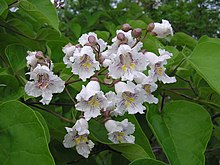Common trumpet tree
| Common trumpet tree | ||||||||||||
|---|---|---|---|---|---|---|---|---|---|---|---|---|

Common trumpet tree ( Catalpa bignonioides ) |
||||||||||||
| Systematics | ||||||||||||
|
||||||||||||
| Scientific name | ||||||||||||
| Catalpa bignonioides | ||||||||||||
| Walter |
The common trumpet tree ( Catalpa bignonioides ) is a deciduous tree from the trumpet tree family (Bignoniaceae) . Its natural range is in the United States, but it was also widely planted as an ornamental tree in Europe. It is often found as a park and street tree. All parts are slightly poisonous.
description
The common trumpet tree reaches a height of 15 to 18 meters. It forms a thick, usually short trunk and a broad, spreading, irregular crown. The bark, which is coarsely scaly in old age, is brown to brown-gray.
The stalked leaves are heart-shaped, 10 to 20 centimeters long, pointy short and with entire margins. The base is truncated or weakly heart-shaped, less often somewhat lobed. The upper side of the leaf is dark green, the underside light green and more or less densely short and softly haired. The leaves are thrown off without autumn color. They smell unpleasant when rubbed, which distinguishes them from other representatives of the trumpet trees.
The bell-shaped and two-lipped, hermaphrodite flowers are pure white and show purple spots and two yellow vertical stripes ( sap marks ) in the throat . They are fivefold with a double flower envelope . They are in 10 to 15 centimeters long multi-flowered panicles and bloom from June to July.
Numerous thin-walled and linear capsules are formed as fruits , which are up to 40 centimeters long and 5 to 7 millimeters wide. They stay on the tree over the winter ( winter cows ) and only open in spring. The winged and flat seeds have a tuft of hair on both ends.
Very old trumpet trees sometimes develop tow-like lower branches that take root themselves and form new trunks.
The number of chromosomes is 2n = 40.
Distribution and location requirements
The natural range extends over the southeastern United States to Florida .
The common trumpet tree grows in floodplains and on river banks and prefers a moderately dry, very nutrient-rich, sandy to gravelly, neutral to alkaline soil. You can find it in sunny locations, it is heat-resistant, but not very frost-hardy.
Systematics
A distinction is made between several cultivars , including
- 'Aurea' with golden yellow shoots and later green leaves.
- 'Nana' with significantly smaller leaves and a densely branched crown that flattens out with age. The cultivar is usually high-stemmed and used as a bucket and street tree.
Botanical history
The common trumpet tree was brought to Europe by the English naturalist Mark Catesby in 1726.
Toxicity
The whole plant is not poisonous, the main active ingredient is catalpin , which is found in all parts except the seeds. About 1.5% p- coumaric acid , ursolic acid and caffeic acid are still found in the leaves . The wood contains quinoid compounds which can lead to an allergic reaction if they come into contact with the skin.
use
The common trumpet tree is used both as a useful plant and as an ornamental wood because of the decorative flowers and the remarkable fruit decorations. The flowers are often approached by bees; the tree is considered a pasture for bees .
proof
literature
- Andreas Roloff , Andreas Bärtels: Flora of the woods. Purpose, properties and use. With a winter key from Bernd Schulz. 3rd, corrected edition. Eugen Ulmer, Stuttgart (Hohenheim) 2008, ISBN 978-3-8001-5614-6 , p. 168.
- Ulrich Hecker: Forest and park trees . blv, Munich 2001, ISBN 3-405-16020-0 , p. 88 .
Individual evidence
- ↑ a b c d e f g h Roloff et al .: Flora der Gehölze , p. 168
- ↑ a b c d Hecker: Forest and Park Trees , p. 88
- ↑ Pictures: Trumpet tree with lowering branches in the Schlosspark Großkmehlen
- ^ Erich Oberdorfer : Plant-sociological excursion flora for Germany and neighboring areas . With the collaboration of Angelika Schwabe and Theo Müller. 8th, heavily revised and expanded edition. Eugen Ulmer, Stuttgart (Hohenheim) 2001, ISBN 3-8001-3131-5 , pp. 862 .
- ↑ Roth, Daunderer, Kormann: Toxic Plants, Plant Poisons . 4th edition. Nikol, Hamburg 1994, ISBN 3-933203-31-7 , pp. 200 .


